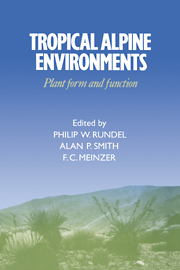Book contents
- Frontmatter
- Contents
- List of contributors
- Preface
- 1 Introduction to tropical alpine vegetation
- 2 Tropical alpine climates
- 3 Páramo microclimate and leaf thermal balance of Andean giant rosette plants
- 4 Comparative water relations of tropical alpine plants
- 5 Cold tolerance in tropical alpine plants
- 6 Anatomy of tropical alpine plants
- 7 Environmental biology of a tropical treeline species, Polylepis sericea
- 8 Morphological and physiological radiation in páramo Draba
- 9 Sediment-based carbon nutrition in tropical alpine Isoetes
- 10 Functional significance of inflorescence pubescence in tropical alpine species of Puya
- 11 Turnover and conservation of nutrients in the pachycaul Senecio keniodendron
- 12 Soil nutrient dynamics in East African alpine ecosystems
- 13 An overview of the reproductive biology of Espeletia (Asteraceae) in the Venezuelan Andes
- 14 Population biology of Mount Kenya lobelias
- 15 Population biology of Senecio keniodendron (Asteraceae), an Afroalpine giant rosette plant
- 16 Population dynamics and flowering in a Hawaiian alpine rosette plant, Argyroxiphium sandwicense
- 17 Plant form and function in alpine New Guinea
- 18 Alpine herbivory on Mount Kenya
- 19 Biotic interactions in Hawaiian high elevation ecosystems
- 20 Tropical alpine ecology: progress and priorities
- Index
12 - Soil nutrient dynamics in East African alpine ecosystems
Published online by Cambridge University Press: 21 October 2009
- Frontmatter
- Contents
- List of contributors
- Preface
- 1 Introduction to tropical alpine vegetation
- 2 Tropical alpine climates
- 3 Páramo microclimate and leaf thermal balance of Andean giant rosette plants
- 4 Comparative water relations of tropical alpine plants
- 5 Cold tolerance in tropical alpine plants
- 6 Anatomy of tropical alpine plants
- 7 Environmental biology of a tropical treeline species, Polylepis sericea
- 8 Morphological and physiological radiation in páramo Draba
- 9 Sediment-based carbon nutrition in tropical alpine Isoetes
- 10 Functional significance of inflorescence pubescence in tropical alpine species of Puya
- 11 Turnover and conservation of nutrients in the pachycaul Senecio keniodendron
- 12 Soil nutrient dynamics in East African alpine ecosystems
- 13 An overview of the reproductive biology of Espeletia (Asteraceae) in the Venezuelan Andes
- 14 Population biology of Mount Kenya lobelias
- 15 Population biology of Senecio keniodendron (Asteraceae), an Afroalpine giant rosette plant
- 16 Population dynamics and flowering in a Hawaiian alpine rosette plant, Argyroxiphium sandwicense
- 17 Plant form and function in alpine New Guinea
- 18 Alpine herbivory on Mount Kenya
- 19 Biotic interactions in Hawaiian high elevation ecosystems
- 20 Tropical alpine ecology: progress and priorities
- Index
Summary
Introduction
The nutrient relations of tropical alpine areas are poorly known despite the importance of these processes for understanding spatial and temporal variation in ecosystem productivity (Speck 1983). Nitrogen mineralization – the release of inorganic nitrogen from the substrate – is of particular importance in this respect, and has proved useful in assessing ecosystem dynamics in the European Alps (Rehder 1970, 1976a, b, 1982; Rehder & Schäfer 1978). In this chapter I address the problem of nitrogen mineralization and its impact on primary productivity in the alpine zone of Mount Kenya.
Materials and methods
Samples areas were established in the two main alpine plant communities of the Teleki Valley, on the western flank of Mount Kenya: ‘Senecio keniodendron–Lobelia telekii community’ (Area 1) on steeper slopes and ‘Lobelia keniensis– Senecio brassica community’ (Area 2) on moderate slopes and valley bottoms (see Table 12.1; also Hedberg 1964; Beck et al. 1981; Rehder 1975, 1983; Rehder et al 1981, 1988). The soil at area 1 was a loamy ‘mountain brown gley soil’ while the soil at area 2 was a blackish peaty ‘mountain wet gley soil’ (Beck et al 1981). Mean maximum temperatures were lower at the soil surface in area 2 (Table 12.2).
Nitrogen mineralization was measured with a field incubation test (Ellenberg 1964, 1977; Gerlach 1973). Volumetric soil samples were taken from three depths between 0 and 15 cm, weighed, sieved (4 mm screen), mixed and homogenized by hand.
- Type
- Chapter
- Information
- Tropical Alpine EnvironmentsPlant Form and Function, pp. 223 - 228Publisher: Cambridge University PressPrint publication year: 1994
- 5
- Cited by



